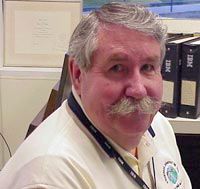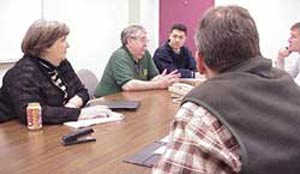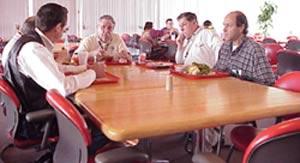
Article written by IBM Corporate staff published in February 2002 on the IBM internal online network.
As usual, he's on the road at 7 a.m. for the drive from Los Altos to the Silicon Valley Lab in San Jose, Calif. He has his morning coffee, runs the regularly scheduled meeting with his design team, and later shoots the breeze with the lunchtime crowd -- always around the same table in the cafeteria -- before heading back to his desk to write some computer code.
 Vern Watts
|
Alone in his office, he peers quizzically into data flying across the monitor. He reaches for a nearby binder, leafs through some pages, taps on a few more keys and then nods his head in satisfaction.
These routines are unremarkable in themselves, but they throw some light on the long, prominent career of Vern Watts, the IBM Distinguished Engineer and chief architect of the database management software IMS, who for 46 years has been striding into work with a store of dedication and persistence.
Watts says the spirit of discovery is what keeps him going when everyone else has given up, and keeps him up when everyone else has gone to bed. And his story reads like a fable, with the moral being: A man who has an inventive spirit and a healthy dose of can-do ingenuity will avoid getting into a deep rut or locked into a dead-end job.
"I think about my job in the car on the way home," he says. "I dream about it at night. I find it totally consuming and fascinating."
Most employees at the lab probably know Watts' face, though they may not know his name. And when new hires -- some only dimly aware of his shining track record here -- drift into his office or run into him in the hall, they're often struck by the positive outlook that's integral to his general well being.
"When people find out what year I started working here, apart from commenting -- 'but I wasn't even born yet!' -- what impresses them most is that I'm still interested in my work, I'm still creative and I have no trouble keeping up with them."
Born in Southern Illinois, Watts graduated from Washington University in St. Louis as a math major before getting drafted into the Army and stationed in Seattle. During his last month of service, he stopped by the local IBM branch office to apply for a job. On January 15, 1956, Watts arrived for his first day of work as a programmer in the Seattle Service Bureau and began to stamp out the patterns of a productive career at IBM.
"It didn't take me long to figure out that IBM and I were a good match," Watts says. "Technology at the time was growing so fast and covering so much ground that I knew that whatever I took an interest in, there would be an opportunity."
Watts' entrance into the company coincided with IBM's breakthrough years in computing. And his resume serves as a valuable chronicle of the early days of computer and data management technology.
It begins with him writing code and application programs for one of the earliest ancestors of the personal computer -- the 650 magnetic drum memory machine. He helped test and support one of the first operating systems -- the 1410. He was called on when the Poughkeepsie lab was looking for a few extra hands to run and test the System/360, one of the first general-purpose, one-size-fits-all mainframe computers. And he played a leading role in crafting the prototype edition of IMS (Information Management System), the first commercially available database management system, which spawned DB2.

Leading a meeting of IMS developers
|
During those early years, it had fallen mainly to the engineers working below the decks to make the first decisions about new products. On weekends, Watts would often be home with his head buried in a thick textbook. By Monday morning, he was an expert on the subject.
"One of the problems with being early in the programing business is that there was nobody around with more experience than you, and a fairly simple program was still complex, because you didn't have any systems support," Watts says. "You had to do everything yourself."
Shortly after Watts was hired into IBM, Tom Watson Jr., who had recently taken over the company from his father, was encouraging employees to be "wild ducks" -- meaning, self-starters who weren't just part of the uniform mass. This made a deep impression on the young engineer: "From the beginning, I wanted to make some kind of difference."
His got his chance with IMS, which he helped dream up and develop in 1966 while serving as the operating systems expert for IBM's Aerospace District. The dogged precision that had been drilled into Watts during his first decade at IBM stood him in good stead as he lead a cadre of programmers on engineering the design of this new hierarchical database management system in which processing and control functions were performed at several levels by computers.
After a bumpy experience trying to sell the idea to the East Coast labs, the team approached the Western Region for funding. The response they got was "find us a customer." North American Aviation was signed on and IMS took off from there, becoming the premier transaction and database management system.

Shooting the breeze with the lunchtime regulars
|
Today, more than 90 percent of the Fortune 1000 companies use IMS to process over 50 million transactions a day and manage over 15 billion gigabytes of critical business data. At customer sites, Watts is often treated like a star. "I can't believe it's Vern Watts," customers have been known to say, as they approach the engineer with outstretched hands.
Bob Gilliam, IMS Product Manager, whose office is right next door to Watts' at SVL, says that what impresses him most about the man is that after accomplishing so much over the years, he has no qualms about getting his hands dirty day in and day out.
"What's remarkable is not just that he's been with IBM for so long," Gilliam says, "it's that he has continued to make contributions of all sizes, from developing new applications to everyday things like writing computer code."
Indeed, two years ago Watts led the way in transforming IMS into a platform for Web-based, high-workload applications. Last year, IBM awarded Watts an Outstanding Technical Achievement Award for his work.
Watts says he is much too busy to hang up his boots in retirement or even head off for an extended vacation. In fact, when he tried taking some time off last year, once he settled in his mind started to spin. And unable to resist, he reached for his ThinkPad and got to work on his next breakthrough idea.